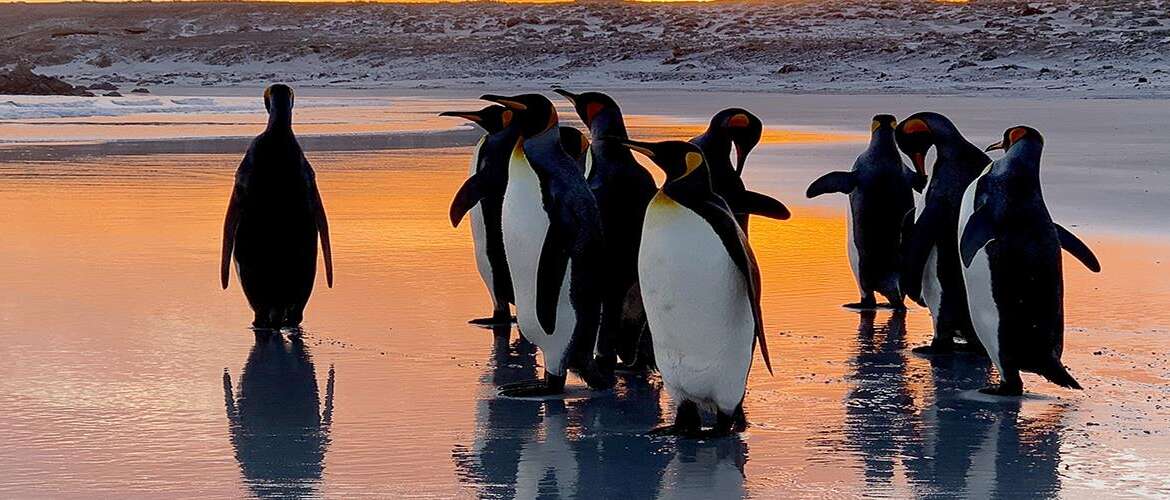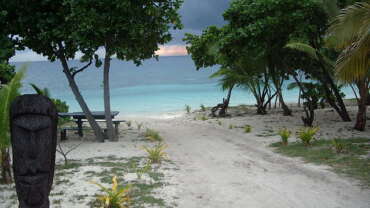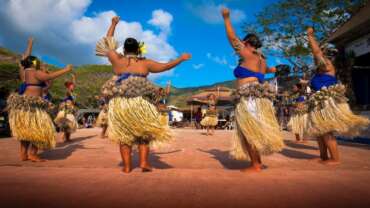Falkland Islands (Islas Malvinas)
The Falkland Islands (Islas Malvinas) are a remote South Atlantic archipelago. With rugged terrain and cliff-lined coasts, its hundreds of islands and islets are home to sheep farms and abundant birdlife. The capital, Stanley, sits on East Falkland, the largest island. The town’s Falkland Islands Museum has themed galleries devoted to maritime exploration, natural history, the 1982 Falklands War and other subjects.
Escape on the Ultimate Island Adventure!
Imagine a place that is so far off the beaten track you have miles of stunning landscape, beaches and magnificent bird life all to yourself. Imagine a silence that is only broken by the call of the birds, and your own footsteps as you explore these beautiful islands in the South Atlantic Ocean.
This is the Falkland Islands, one of the last great wilderness destinations where your trip becomes an adventure. Four wheel drives are our mode of transport, and our little planes will take you to islands abundant with penguins, albatrosses and petrels that are there for you alone to discover and enjoy.
At the end of each day you can look forward to traditional cosy Falkland Islands hospitality in the hotels, lodges and guesthouses scattered around the islands.
Escape on a holiday like no other.
History of Falkland Islands
The Falkland Islands have a rich history embracing maritime trade, sealing, whaling, cattle and sheep farming.
The English navigator, John Davis, aboard the “Desire” made the first confirmed sighting of the Islands in 1592. The first landing is attributed to the British Captain, John Strong, in 1690 at Bold Cove, Port Howard on West Falkland.
Early visitors were sealers, whalers and penguin hunters from different corners of the World. Many imported domestic animals and left these at various locations as a food source for future voyages. Cattle spread rapidly throughout the Islands. Travel was on horseback and South American gauchos made their mark. Stone and turf corrals were constructed and remains of these can be seen scattered across the Islands, particularly on East Falkland.
1833 saw the re-assertion by Britain of its sovereignty. By 1845 the capital had been moved to its present site and named Stanley, after the Colonial Secretary, Geoffrey Smith Stanley. Stanley became an important port for vessels involved in whaling and rounding Cape Horn. Settlements and farms were built around the Islands and sheep farming took over from cattle ranching as the mainstay of the economy.
Falkland Islanders participated in both World Wars. The World War One Battle of the Falklands is commemorated by a monument on Ross Road while the Cross of Sacrifice commemorates World War Two. For 74 days in 1982, Argentine troops occupied the Falkland Islands. A British Task Force was sent to recover the Islands. Fierce fighting took place on land, at sea and in the air with a number of Islanders aiding the British military wherever possible. Ultimately, Argentine Forces surrendered to the British Forces.
Today the Islands enjoy a healthy economy based on the sale of fishing licences, tourism and agricultural products including fine wool, mutton and beef.
Essential Information of Falkland Islands
Health
The Falkland Islands Government Health Service is responsible for the provision of all medical services including dental care. The general standard of health within the Falklands is rated as good and visitors to the Islands require no vaccinations. All health-care facilities are based at the King Edward VII Memorial Hospital (KEMH) in Stanley where medical staff are qualified to UK standards, including a full surgical team.
Other settlements and farms are equipped with medicine chests to meet everyday needs and take care of minor injuries. If necessary, arrangements will be made for transportation to Stanley.
Visitors to the Islands, other than those who are UK residents, are required to pay for any medical services received in the Islands. Travel insurance, inclusive of medical evacuation by plane, is needed to stay in the Falklands.
Over-the-counter medicines, including pain-killers, indigestion remedies and medicinal dressings, can be easily purchased in supermarkets in Stanley. If you take prescribed medicines, it is highly recommended that you bring sufficient supplies for the length of your stay and to allow for contingencies. It is also a good idea to bring a copy of your prescription. If you cannot find the medicine you need in the shops, the pharmacy at the KEMH will assist but please remember that if an item is not part of their stock it will need to be ordered from overseas and take a few days to arrive.
Banking and money
There is only one bank, the Standard Chartered Bank (SCB) located on Ross Road, Stanley. It opens weekdays until 3pm. The SCB can change money, transfer funds and issue cash advances against Visa and Mastercard credit cards. Charges apply and photographic identification is essential.
Local currency has the same value as UK sterling and both circulate freely in the Islands. US dollars are widely accepted and euros can be used in some places. Similarly, some credit and debit cards can be used in some locations. It’s a good idea to check your method of payment in advance and it is highly recommended to carry cash for use outside of Stanley.
Communications
All communication services, Island-wide, are provided by Sure.
If you have a contract phone you may be able to use the local mobile (cellphone) network with your own SIM card. The Sure website has an up-to-date list of roaming partners. Ensure in advance that roaming is activated. A pay-as-you-go service is also available and may be a cheaper option if you are visiting for more than a day. You will need a SIM-free (unlocked) phone. Mobile coverage is good in Stanley and a number of other locations but is not set up island-wide.
Stanley has a small number of public phone boxes which can be used with pre-paid cards available from some shopping outlets.
Wi-fi hotspots exist at many locations around the Islands. A wi-fi card is needed; these can usually be purchased at the place where a hot-spot is situated. Wi-fi does not exist everywhere. Getting away from wi-fi may be an attraction but if access is really important to you, check the Sure website for the latest information on availability.
Entry and Exit requirements
All visitors require a passport valid for the length of their stay.
Land-based travellers should also have travel insurance (inclusive of evacuation by plane), a return ticket, evidence of accommodation and sufficient personal funds for their time in the Islands. A small number of nationalities require a visa. A departure tax must be paid on embarking from the international airport. Payable in cash in £FK, £GB, euros or $US (Currently £26). This can also be paid by card for debit or credit, Visa and MasterCard only.
Further information is available from the Falkland Islands Customs and Immigration Department.
Biosecurity
Biosecurity is concerned with preventing new pests, diseases or invasive species from entering the Islands.
Visitors are respectfully asked not to bring risk foods into the Islands and to check their clothes and equipment for risk organisms. Risk foods include meat and poultry products, unpasteurised dairy products, eggs, uncooked vegetables and some fruits. Risk organisms can be spread from dirty footwear, clothing, bags and fishing equipment. Seeds and insects are not always easy to spot and may be inadvertently brought in and transferred from island to island.
Language
The official language of the Islands is English.
Many nationalities are represented in the Islands, therefore a range of languages can be found, albeit spoken by just a small number of individuals. In an emergency situation, efforts will be made to find a suitable translator.
Electricity supply
The electricity supply is 240v, 50hz with a standard UK 3-pin plug.
Cruises to the Falkland Islands
The Falkland Islands feature on itineraries for many cruise companies. Ships visiting the Islands vary greatly in size from small ice-breaking yachts to large, luxury vessels with passenger numbers from as little as ten to as many as three thousand.
Small vessels usually include the Falklands as part of an Antarctic route incorporating South Georgia and the Antarctic peninsula. Most will call in to one or more of the outlying islands, offering fantastic wildlife viewing opportunities and exhilarating walks along hills, cliff-tops or around the shoreline. Zodiac craft (inflatable small boats) provide transport from ship to shore.
Large ships generally tour South America with a stop in the Falklands en route around Cape Horn.
All vessels have the Island’s capital Stanley, scheduled as part of the tour. Passengers may arrive ashore by tender, inflatable zodiac or disembark directly at Stanley’s floating dock facility. The Visitor Centre is the ideal starting point for any visit, providing information about the city and connecting visitors with tours and transport. Tenders arrive at pontoons directly in front of the Centre. The floating dock is a short bus-ride with courtesy transport provided.
Shore excursions can be booked on board ship which is the recommended option for anyone keen to take a tour. The range on offer is tremendous from various trips to penguin colonies and farms, Stanley’s highlights by bus, battlefield and walking tours.
Small buses run regularly to the nearby penguin colony at Gypsy Cove and the city is easy to explore on foot but to get the best from your visit, a tour with a local guide is highly recommended. Stanley’s population is relatively small and many hands turn-to when a large ship calls. Some guides can be found at the Visitor Centre but advance booking is essential to guarantee an excursion on a busy day.
Stanley - The Island's tiny capital

Stretched along the sheltered harbour, the colourful buildings of Stanley bid a warm and friendly welcome to all visitors. Our tiny capital city is village-sized but has the amenities you would expect of a large town and lots to discover.
Different architectural styles characterise Stanley along with features of our British heritage. There are interesting buildings to explore and some surprising photographic opportunities.
Christ Church Cathedral is a must-see whatever your beliefs. The world’s most southerly Anglican Cathedral has beautiful stained glass windows, flags, banners and artefacts that tell stories of Island life. Alongside is the Whalebone Arch, a magnificent construction from the jawbones of blue whales. Pioneers made their homes in the kit cottages of Drury Street and Pioneer Row. Today these are mainly private houses but create an excellent photographic opportunity whilst Cartmell Cottage, belonging to the Museum and National Trust, allows visitors to step back in time and experience that pioneering spirit of old.
Stroll along the seafront and you will pass Victory Green with the mizzen mast from the sailing ship, the SS Great Britain. A reminder of times past, Stanley has an interesting maritime history to uncover and you can learn more about this and other aspects of social and natural history in the Dockyard Museum, another definite stop for any visitor.
The Governor’s residence, workplace and beautifully-kept gardens, Government House is a much-photographed building and talking point. Memorials also feature along the seafront, the Battle of the Falklands, World War II, the 1982 conflict and a special monument for the Royal Marines.
Keen walkers can venture further afield to enjoy the views from the hills around Stanley or the stunning beaches. Find a local guide to show you all the sights, on foot or from the comfort of a 4×4 vehicle.






